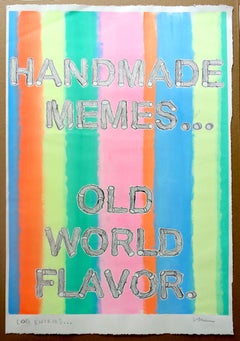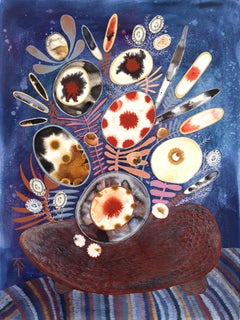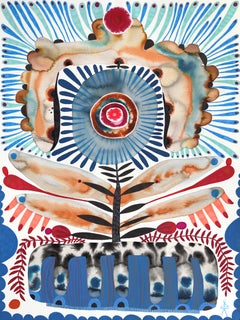David Kramer Abstract Drawings and Watercolors
to
1
Overall Width
to
Overall Height
to
1
1
1
1
1
1
9
138
110
89
77
1
Artist: David Kramer
Satirical Text Based Conceptual Painting: "Log Entries..."
By David Kramer
Located in New York, NY
38"x27" signed by the artist, David Kramer. (acrylic, pencil on gessoed paper) In this conceptual work on paper, the text "Handmade Memes... Old World Flavor." is hand drawn to loo...
Category
2010s Conceptual David Kramer Abstract Drawings and Watercolors
Materials
Paper, Oil, Pencil
Related Items
Flower Arrangement in Carved Wooden Bowl - Abstract Botanical Painting on Paper
Located in Los Angeles, CA
Krisanne Souter weaves together elements of nature and ancient feminine archetypes, such as the Mother and the Mystic. Botanical themes, playful elements, and unexpected surprises ar...
Category
21st Century and Contemporary Abstract David Kramer Abstract Drawings and Watercolors
Materials
Paper, Ink, Acrylic, Watercolor, Color Pencil
Plant in Pottery Pot 2 - Original Abstract Colorful Botanical Painting on Paper
Located in Los Angeles, CA
Krisanne Souter weaves together elements of nature and ancient feminine archetypes, such as the Mother and the Mystic. Botanical themes, playful elements, and unexpected surprises ar...
Category
21st Century and Contemporary Abstract David Kramer Abstract Drawings and Watercolors
Materials
Paper, Ink, Acrylic, Watercolor, Color Pencil
Neptune Flower Arrangement - Abstract Botanical Mixed Media Painting on Paper
Located in Los Angeles, CA
Krisanne Souter weaves together elements of nature and ancient feminine archetypes, such as the Mother and the Mystic. Botanical themes, playful elements, and unexpected surprises ar...
Category
21st Century and Contemporary Abstract David Kramer Abstract Drawings and Watercolors
Materials
Paper, Ink, Acrylic, Watercolor, Color Pencil
Tepoztlan II unique signed framed work on paper by renowned artist Joyce Kozloff
By Joyce Kozloff
Located in New York, NY
Joyce Kozloff
Tepoztlan II, 1973
Gouache and colored pencil on paper
Signed, dated and titled twice: once on the back of the work (shown) and once on the original board which has bee...
Category
1970s Conceptual David Kramer Abstract Drawings and Watercolors
Materials
Gouache, Color Pencil
$19,450
H 27.5 in W 35 in D 2 in
Intersecting Magic Square
By Charmion von Wiegand
Located in New York, NY
Charmion von Wiegand
Intersecting Magic Square, ca. 1963
Gouache on paperboard
Signed and titled on the back of the artwork. The signature shown on the frame back is a photo of the actual signature on the artwork itself.
Frame Included: elegantly floated and framed in hand made white wood museum frame with UV plexiglass
This work is signed and titled on the back of the artwork itself. The signature shown on the back of the frame is a photo of the actual signature, since the actual pencil signature and title is on the artwork itself, which can't be seen within the frame
Measurements:
Frame:
21 x 17 x 1.5 inches
Artwork:
18 x 14.25 inches
The Estate of the celebrated artist Charmion Von Wiegand has been represented exclusively by Michael Rosenfeld...
Category
1960s Abstract Geometric David Kramer Abstract Drawings and Watercolors
Materials
Gouache, Handmade Paper, Mixed Media, Pencil
Mandorla - Large Format Charcoal On Paper, Black White Drawing
By Krzysztof Gliszczyński
Located in Salzburg, AT
Krzysztof Gliszczyński is Professor for painting on Academy of fine arts Gdansk.
The artwork is unframed and will be shipped rolled in a tube
Artist Statement
In the 1990s I started collecting flakes of paint – leftovers from my work. I would put fresh ones in wooden formworks, dried ones in glass containers. They constituted layers of investigations into the field of painting, enclosed in dated and numbered cuboids measuring 47 × 10.5 × 10.5 cm. I called those objects Urns. In 2016, I displayed them at an exhibition, moulding a single object out of all the Urns. The Urns inspired me to redefine the status of my work as a painter. In order to do it, I performed a daunting task of placing the layers of paint not in an urn, but on a canvas, pressing each fresh bit of paint with my thumb. In the cycle of paintings Autoportret a’retour, the matter was transferred from painting to painting, expanding the area of each consecutive one. Together, the bits, the residua of paint, kept alive the memory of the previous works. It was a stage of the atomization of the painting matter and its alienation from the traditional concepts and aesthetic relations. Thus, the cycle of synergic paintings was created, as I called them, guided by the feeling evoked in me by the mutually intensifying flakes of paint. The final aesthetic result of the refining of the digested matter was a consequence of the automatism of the process of layering, thumb-pressing, and scraping off again. Just like in an archaeological excavation, attempts are made to unite and retrieve that which has been lost. This avant-garde concept consists in transferring into the area of painting of matter, virtually degraded and not belonging to the realm of art. And yet the matter re-enters it, acquiring a new meaning. The matter I created, building up like lava, became my new technique. I called it perpetuum pictura – self-perpetuated painting. Alchemical concepts allowed me to identify the process inherent in the emerging matter, to give it direction and meaning. In a way, I created matter which was introducing me into the pre-symbolic world – a world before form, unnamed. From this painterly magma, ideas sprung up, old theories of colour and the convoluted problem of squaring the circle manifested themselves again. Just like Harriot’s crystal refracted light in 1605, I tried to break up colour in the painting Iosis. Paintings were becoming symptoms, like in the work Pulp fiction, which at that time was a gesture of total fragmentation of matter and of transcending its boundaries, my dialogue with the works of Jackson Pollock and the freedom brought by his art. The painting Geometrica de physiologiam pictura contains a diagram in which I enter four colours that constitute an introduction to protopsychology, alchemical transmutation, and the ancient theory of colour. It this work I managed to present the identification of the essence of human physiology with art. But the essential aspect of my considerations in my most recent paintings is the analysis of abstraction, the study of its significance for the contemporary language of art and the search for the possibilities of creating a new message. For me, abstraction is not an end in itself, catering to the largely predicable expectations of the viewers. To study the boundary between visibility and invisibility, like in the work Unsichtbar, is to ask about the status of the possibilities of the language of abstraction. The moment of fluidity which I am able to attain results from the matter – matter...
Category
Early 2000s Conceptual David Kramer Abstract Drawings and Watercolors
Materials
Paper, Charcoal
$2,989
H 78.75 in W 59.06 in
Light, Series Drawing From Israel - Large Format, Charcoal On Paper
By Krzysztof Gliszczyński
Located in Salzburg, AT
The artwork is unframed and will be shipped rolled in a tube
Krzysztof Gliszczyński is Professor for painting on Academy of fine arts Gdansk.
Krzysztof Gliszczyński born in Miastko in 1962. Graduated from the Gdańsk Academy of Fine Arts in 1987 in the studio of Prof. Kazimierz Ostrowski. Between 1995 and 2002 founder and co-manager of Koło Gallery in Gdańsk. lnitiator of the Kazimierz Ostrowski Award, con-ferred by the Union of Polish Artists and Designers (ZPAP), Gdańsk Chapter. Dean of the Painting Faculty of the Gdańsk Academy of Fine Arts in the years 2008-2012. Vice Rector for Development and Cooperation of the Gdańsk Academy of Fine Arts in the years 2012-2016. Obtained a professorship in 2011. Currently head of the Third Painting Studio of the Painting Faculty of the Gdańsk Academy of Fine Arts. He has taken part in a few dozen exhibitions in Poland and abroad. He has received countless prizes and awards for his artistic work. He is active in the field of painting, drawing, objects, and video.
Artist Statement
In the 1990s I started collecting flakes of paint – leftovers from my work. I would put fresh ones in wooden formworks, dried ones in glass containers. They constituted layers of investigations into the field of painting, enclosed in dated and numbered cuboids measuring 47 × 10.5 × 10.5 cm. I called those objects Urns. In 2016, I displayed them at an exhibition, moulding a single object out of all the Urns. The Urns inspired me to redefine the status of my work as a painter. In order to do it, I performed a daunting task of placing the layers of paint not in an urn, but on a canvas, pressing each fresh bit of paint with my thumb. In the cycle of paintings Autoportret a’retour, the matter was transferred from painting to painting, expanding the area of each consecutive one. Together, the bits, the residua of paint, kept alive the memory of the previous works. It was a stage of the atomization of the painting matter and its alienation from the traditional concepts and aesthetic relations. Thus, the cycle of synergic paintings was created, as I called them, guided by the feeling evoked in me by the mutually intensifying flakes of paint. The final aesthetic result of the refining of the digested matter was a consequence of the automatism of the process of layering, thumb-pressing, and scraping off again. Just like in an archaeological excavation, attempts are made to unite and retrieve that which has been lost. This avant-garde concept consists in transferring into the area of painting of matter, virtually degraded and not belonging to the realm of art. And yet the matter re-enters it, acquiring a new meaning. The matter I created, building up like lava, became my new technique. I called it perpetuum pictura – self-perpetuated painting. Alchemical concepts allowed me to identify the process inherent in the emerging matter, to give it direction and meaning. In a way, I created matter which was introducing me into the pre-symbolic world – a world before form, unnamed. From this painterly magma, ideas sprung up, old theories of colour and the convoluted problem of squaring the circle manifested themselves again. Just like Harriot’s crystal refracted light in 1605, I tried to break up colour in the painting Iosis. Paintings were becoming symptoms, like in the work Pulp fiction, which at that time was a gesture of total fragmentation of matter and of transcending its boundaries, my dialogue with the works of Jackson Pollock and the freedom brought by his art. The painting Geometrica de physiologiam pictura contains a diagram in which I enter four colours that constitute an introduction to protopsychology, alchemical transmutation, and the ancient theory of colour. It this work I managed to present the identification of the essence of human physiology with art. But the essential aspect of my considerations in my most recent paintings is the analysis of abstraction, the study of its significance for the contemporary language of art and the search for the possibilities of creating a new message. For me, abstraction is not an end in itself, catering to the largely predicable expectations of the viewers. To study the boundary between visibility and invisibility, like in the work Unsichtbar, is to ask about the status of the possibilities of the language of abstraction. The moment of fluidity which I am able to attain results from the matter – matter...
Category
Early 2000s Conceptual David Kramer Abstract Drawings and Watercolors
Materials
Paper, Charcoal
$2,989
H 86.62 in W 59.06 in
Untitled 1 - Expressive Charcoal On Paper Painting, Black White Drawing
By Krzysztof Gliszczyński
Located in Salzburg, AT
The paper of the work is not yellowed, there is a applied yellowed primer under the drawing
Krzysztof Gliszczyński is Professor for painting o...
Category
Early 2000s Conceptual David Kramer Abstract Drawings and Watercolors
Materials
Paper, Charcoal
$1,315
H 19.69 in W 27.56 in
Berlin
By Peter Soriano
Located in London, GB
Spray paint, pencil, ink, watercolor on paper. Unframed.
Peter Soriano works on relatively large sheets of Japanese paper with a tendency to work from something observed, ideally ar...
Category
2010s Conceptual David Kramer Abstract Drawings and Watercolors
Materials
Paper, Ink, Spray Paint, Watercolor, Pencil
TWO SPACES - Expressive Charcoal On Paper Painting, Black White Drawing
By Krzysztof Gliszczyński
Located in Salzburg, AT
The work is on 1 paper.
Krzysztof Gliszczyński is Professor for painting on Academy of fine arts Gdansk.
The artwork is unframed and will be...
Category
Early 2000s Conceptual David Kramer Abstract Drawings and Watercolors
Materials
Paper, Charcoal
$1,853
H 39.38 in W 27.56 in
Porch drawing 2 (Abstract Painting)
By Peter Soriano
Located in London, GB
Porch drawing 2 (Abstract Painting)
Spray paint, pencil, ink, watercolor on paper. Unframed.
Peter Soriano works on relatively large sheets of Japanese paper with a tendency to work from something observed, ideally around him. He tends to be “in” the configuration that is the subject of the work.
Soriano is fond of “systems” objects attached to other objects, such as the wiring plan of a room. But very often there are other shapes that play a role in the work.
The artist would fold and rework a piece a number of times. Folding seems to concentrate the dialogue that attracts him. Reworking is part of his nature. The finished work normally is the result of this ebb and flow between the heightening and repositioning the relationship between forms.
This drawing highlights the configurations of a large porch that Soriano used as a studio in Maine during Summer 2010.
Peter Soriano is a Philippines-born French-American abstract artist who divides his time between New York City and Penobscot, Maine. Although he began his career as a sculptor, his work is now two-dimensional. He is known for his bold spray-painted wall murals...
Category
2010s Conceptual David Kramer Abstract Drawings and Watercolors
Materials
Paper, Ink, Spray Paint, Watercolor, Pencil
Many Wonderful, Colorful Geometric Abstraction with Bold Overlapping Shapes
Located in New York, NY
This vibrant watercolor by Sarah Brenneman features bold, interlocking geometric forms in bright hues of yellow, red, blue, green, and pink, all outlined with a sense of sculptural d...
Category
2010s Abstract David Kramer Abstract Drawings and Watercolors
Materials
Watercolor, Archival Paper, Pencil
David Kramer abstract drawings and watercolors for sale on 1stDibs.
Find a wide variety of authentic David Kramer abstract drawings and watercolors available for sale on 1stDibs. You can also browse by medium to find art by David Kramer in oil paint, paint, paper and more. Not every interior allows for large David Kramer abstract drawings and watercolors, so small editions measuring 27 inches across are available. Customers who are interested in this artist might also find the work of Patricia Smith, Lidzie Alvisa, and Jo Yarrington. David Kramer abstract drawings and watercolors prices can differ depending upon medium, time period and other attributes. On 1stDibs, the price for these items starts at $4,000 and tops out at $4,000, while the average work can sell for $4,000.


